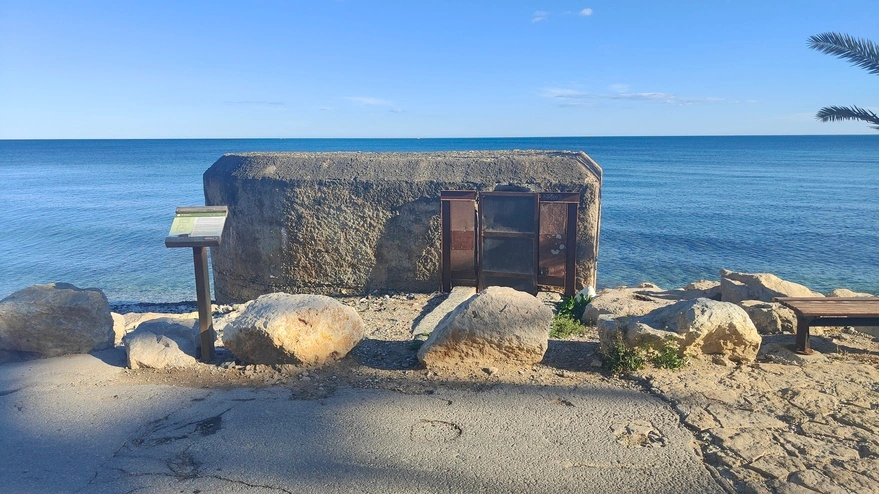The Spanish Civil War left a deep cultural legacy in all the coastal municipalities of Spain, including the town of Altea. The historical memory of this period has been kept alive over the years, and is an important part of the town's identity.
War bunkers in the Bay of Altea

On the beaches of L'Olla and Cap Negret in Altea are the last two machine gun batteries in Altea that are still standing. Built during 1937 by the Republican army during the Spanish Civil War, these bunkers are an important part of the region's history and a tourist attraction for visitors.
Originally, up to 8 of these bunkers were built, and they were used to defend the entire coast of the bay of Altea (beaches of L'Albir, Altea and Mascarat) from possible naval attacks by the fascist allies, whether Spanish, Italian or German. Anecdotally, they were never used and were simply abandoned.

In military terminology, this type of defensive construction is known as a casemate. They were built in concrete and some of them were the work of Mateu Signes, a master builder from Altea. The dimensions of these machine-gun nests are 5 metres long and 4 metres wide. Although there may be some variation between each of them, the height of the bunkers is 1.85 metres, with walls approximately 70 cm wide. Inside the bunkers, the machine guns (which were never installed) would protrude through windows or hatches.

The total list of bunkers that were built on the coast of Altea is as follows:
- La Olla beach bunker. It is the bunker in the best condition, largely because it was built on a solid base that prevents the movement of gravel due to the action of the sea from causing it to collapse. The access is closed by a metal gate, thus preventing the interior from being vandalised.
- Cap Negret beach bunker. It is slightly sunken in the pebbles and stones of the beach. It is very close to the promenade, there is nothing to prevent you from going inside, although we do not recommend it, as the sea waves have been breaking the front part and its interior is, most of the time, flooded.
- Cap Negret tombolo bunker. It is located under the tombolo of Cap Negret, on its southern side, and can be accessed from the beach itself. Some of its stones are still preserved, which even contain basaltic stones from the volcanic enclave of Cap Negret itself, giving it a characteristic blackish colour.
- Cap Blanc beach bunker. This bunker is now submerged in the water and can be clearly seen from the promenade leading to Albir beach.
- Bunker at the mouth of the river Algar. It is now in total ruins, with only a few stones scattered around the area.
- Bunker of the Port of Altea. Lost.
- La Roda beach bunker. Lost.
- Albir beach bunker. Lost.
Enhancing the bunkers on Altea beach

With the recovery of the bunkers on the beach of Altea, there are already many historical monuments that the town council of Altea has been putting in value and recovered for restoration in recent years, such as the Molí dels Moros, the old washing place of Altea, the Portal Nou or the Municipal Historical Archive.
As we said before, the councillor for justice, public administration, democratic reforms and public freedoms visited the bunkers in 2017 to present the objectives of Historical Memory of the town hall of Altea and, subsequently, several field studies were carried out for their enhancement and preservation.
Through an international volunteer programme, excavation work began on the inside of the machine gun nest on La Olla beach to remove the sediment and stones that the sea brought into the bunker.
Archaeologist Pedro Jaime Zaragozí tells it perfectly in the documentary Temps de Guerra i Fam (Times of War and Hunger) made by Salvador Gomis and Juan V. Martín for the town hall of Altea. In this documentary, the people of Altea themselves tell their experiences in first person during the civil war and the post-war period.
Discovering Altea's heritage
Altea is one of the most beautiful and picturesque coastal towns in Spain. It is known as the Dome of the Mediterranean and the Spanish Santorini. Its narrow, whitewashed streets are characteristic of the traditional fishing villages of the Mediterranean and the Spanish coast.
It is also the cultural capital of the Valencian Community and a member of the list of the most beautiful villages in Spain. Therefore, it is not surprising that in this Alicante municipality we can find a great cultural and architectural attraction.
Above all, Altea is known for its neoclassical church, well known for its blue dome. But we can also find numerous hermitages scattered throughout the municipality, which are very attractive and can be visited on a hiking route. Also, speaking of Altea's churches, we find the Russian church of Altea, the colloquial name given to the Orthodox Church of the Temple of the Archangel Michael, in the foothills of the Altea Hills development.
Among its historical heritage we can also mention the bastion of Bellaguarda, which is still in perfect condition and is well worth a stroll through its streets and tower.
Latest blog entries

Tourist Rental Law in the Valencian Community (2025): Complete Guide
19 November, 2025

Exclusive Apartments on the Top Floor: Benefits, Lifestyle and Market Trends on the Costa Blanca & Ibiza
31 October, 2025

Solar energy on the Costa Blanca: profitability and added value for luxury homes
29 October, 2025
